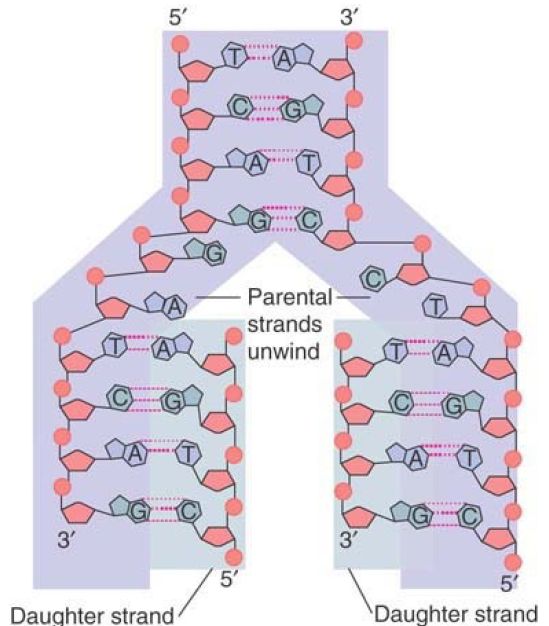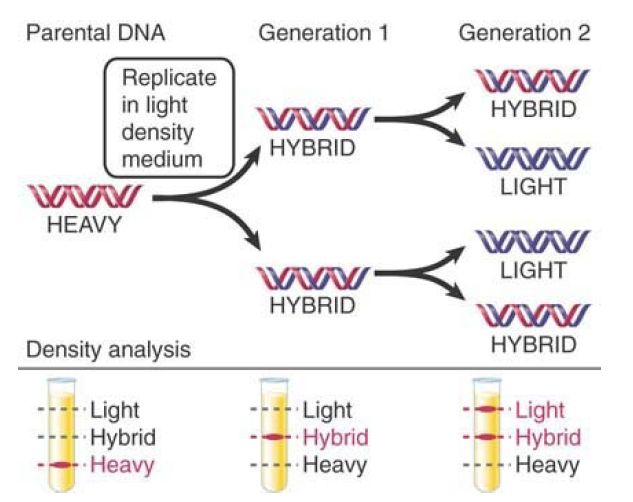


 النبات
النبات
 الحيوان
الحيوان
 الأحياء المجهرية
الأحياء المجهرية
 علم الأمراض
علم الأمراض
 التقانة الإحيائية
التقانة الإحيائية
 التقنية الحيوية المكروبية
التقنية الحيوية المكروبية
 التقنية الحياتية النانوية
التقنية الحياتية النانوية
 علم الأجنة
علم الأجنة
 الأحياء الجزيئي
الأحياء الجزيئي
 علم وظائف الأعضاء
علم وظائف الأعضاء
 الغدد
الغدد
 المضادات الحيوية
المضادات الحيوية|
Read More
Date: 2025-01-29
Date: 2025-02-13
Date: 2025-03-04
|
DNA Replication Is Semiconservative
KEY CONCEPTS
-The Meselson–Stahl experiment used “heavy” isotope labeling to show that the single polynucleotide strand is the unit of DNA that is conserved during replication.
-Each strand of a DNA duplex acts as a template for synthesis of a daughter strand.
-The sequences of the daughter strands are determined by complementary base pairing with the separated parental strands.
To ensure the fidelity of genetic information, it is crucial that DNA is reproduced accurately. The two polynucleotide strands are joined only by hydrogen bonds, so they are able to separate without the breakage of covalent bonds. The specificity of base pairing suggests that both of the separated parental strands could act as template strands for the synthesis of complementary daughter strands. FIGURE 1. shows the principle that a new daughter strand is assembled from each parental strand. The sequence of the daughter strand is determined by the parental strand: An A in the parental strand causes a T to be placed in the daughter strand; a parental G directs incorporation of a daughter C; and so on.

FIGURE 1. Base pairing provides the mechanism for replicating DNA.
The top part of Figure 1. shows an unreplicated parental duplex with the original two parental strands. The lower part shows the two daughter duplexes produced by complementary base pairing. Each of the daughter duplexes is identical in sequence to the original parent duplex, containing one parental strand and one newly synthesized strand. The structure of DNA carries the information needed for its own replication. The consequences of this mode of replication, called semiconservative replication, are illustrated in FIGURE 2. The parental duplex is replicated to form two daughter duplexes, each of which consists of one parental strand and one newly synthesized daughter strand. The unit conserved from one generation to the next is one of the two individual strands comprising the parental duplex.

FIGURE 2. Replication of DNA is semiconservative.
Figure 1. illustrates a prediction of this model. If the parental DNA carries a “heavy” density label because the organism has been grown in a medium containing a suitable isotope (such as
N), its strands can be distinguished from those that are synthesized when the organism is transferred to a medium containing “light” isotopes. The parental DNA is a duplex of two “heavy” strands (red). After one generation of growth in a “light” medium, the duplex DNA is “hybrid” in density—it consists of one “heavy” parental strand (red) and one “light” daughter strand (blue).
After a second generation, the two strands of each hybrid duplex have separated. Each strand gains a “light” partner so that now one half of the duplex DNA remains hybrid and the other half is entirely “light” (both strands are blue).
In this model, the individual strands of these duplexes are entirely “heavy” or entirely “light” but never some combination of “heavy” and “light.” This pattern was confirmed experimentally by Matthew Meselson and Franklin Stahl in 1958. Meselson and Stahl followed the semiconservative replication of DNA through three generations of growth of E. coli. When DNA was extracted from bacteria and separated in a density gradient by centrifugation, the DNA formed bands corresponding to its density—“heavy” for parental, hybrid for the first generation, and half hybrid and half “light” in the second generation.



|
|
|
|
دخلت غرفة فنسيت ماذا تريد من داخلها.. خبير يفسر الحالة
|
|
|
|
|
|
|
ثورة طبية.. ابتكار أصغر جهاز لتنظيم ضربات القلب في العالم
|
|
|
|
|
|
|
العتبة العباسية المقدسة تستعد لإطلاق الحفل المركزي لتخرج طلبة الجامعات العراقية
|
|
|